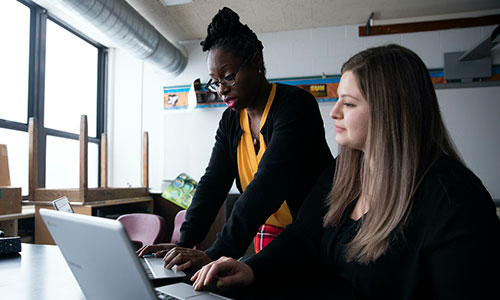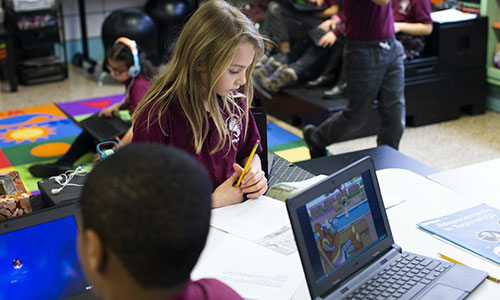
Not all teachers feel confident meeting the needs of the students with disabilities in their general education classroom. If that’s true for you, here are three specific things to try as you work to ensure all the students in your classroom receive the instruction they need.
Tip 1: See if there are overlapping accommodations and modifications
Each student in special education has an individual education plan (IEP) written by their special ed teacher, often referred to as a case manager, and developed in team meetings (which you can attend!). If a student in your class has an IEP, ask for access to that document and read through it. It may be available digitally if your school uses a learning management system. If it’s not, ask their case manager for a hard copy. Regardless of how you get the IEP, think of it as your first opportunity to build a relationship with that case manager. It will be invaluable for you to be able to consult about the needs of students you share throughout the year.
I’d like to point out three especially valuable sections in any IEP. While these documents vary a bit from state to state, all should include the following sections. (To take a look at a sample IEP, visit the Oregon Department of Education’s website for copies of the Oregon Standard IEP form in multiple languages.)
- Present level of educational performance. This first section explains a student’s current level of performance. Sometimes referred to by the acronyms PLOP, PLAAFP, or PLP, it discusses the strengths, interests, preferences, and needs of a student. It usually breaks down by major academic area and details areas of skill, deficit, or strength in reading, writing, and math. In addition to the academic areas, this section also discusses areas including attendance, communication, and social-emotional, study, and motor skills.
- Services. Later in an IEP, you’ll notice a section dedicated to documenting services a student receives. It lists both the service time and area a student in special education is legally entitled to and the location of those services. For example, you may have a student who needs reading services in the special education setting. Chances are they have resource-room time built into their schedule or pull-out services with a special education teacher during your class.
- Supplementary aids and services. Here you’ll see what accommodations or modifications (they’re not the same thing!) a student needs to have equitable access to your general education classroom. These are supports like extended time, reduced problem sets, and access to math charts or tools, a calculator, and text-to-speech.
As part of your planning process, I recommend pulling all your students’ IEPs together and comparing and contrasting them, especially the sections noted above. Getting a complete picture of what all your students with disabilities will need this year can help you save time because, if there’s some overlap, you can make fewer plans for differentiating instruction. It can also help you ensure you’re meeting the needs of all the children in your class. You can sort the information into two groups.
- Common accommodations or modifications. If all or most of your students with disabilities have a certain accommodation or modification, you can start including that in all your lessons or on your assessments (more on that a little later) and making those supports available with your lesson materials. This approach will likely benefit all the students in your class, regardless of disability status, because plenty of kids who aren’t in special education can have difficulties in many of the same ways when learning math, reading, writing, behavior, and communication skills.
- Unique accommodations and modifications. Some students will have needs that are unique to them. These students will require more planning from you. They can be bigger pieces, such as break cards for kinesthetic learning or emotional regulation deficits that allow students to exit the classroom. These cards allow kids to step outside so they can reregulate and use coping skills to deal with emotions, stress, or academic demands. In addition, their sensory needs can be met by moving or burning excess energy. Planning the best time for this is key so students do not miss key concepts. Students with fine or gross motor deficits may also need adaptive technology supports, so sharing PowerPoint slides, Kahoot! content, or other digital resources may require additional planning.
Tip 2: Increase guided practice
After you’ve studied all the IEPs for your students, your thinking will inevitably shift to, “Okay, well, how? And with what time?” These are important concerns.
While we cannot increase the length of the bell schedule, we can shift the structure of the lesson plans we use. Lesson plans that allow for a gradual release of responsibility can help. They rely on a larger guided practice section, which can help you create more opportunities to implement accommodations. Guided practice is a part of the gradual release model “I do. We do. You do.”
When tackling the “I do” section, limit how much time you spend speaking so the information you’re providing is in digestible chunks. The “We do” is a modeling collaboration between you and your students that solidifies concepts from the beginning of a lesson. Intervals of teacher guidance through modeling and formative questioning strategies, followed by independent student work (the “You do”), will allow you to move through the classroom and implement individual accommodations and/or modifications. In addition, you can provide individual or small-group modeling, do checks for understanding, or break tasks up into pieces for certain students. Proximity interventions can increase in longer guided practice sections, which enables more one-on-one check-ins.
Tip 3: Plan for accessible assessment
Tip #1 deals with your daily lesson plans and the acquisition of knowledge students need to move up Bloom’s Taxonomy and develop content proficiency. Tip #2 targets what to focus on during instruction. Now let’s talk about assessment.
IEPs contain precise accommodations or modifications for assessment, and they can be different from lesson accommodations or modifications. These will likely be found in a different section of the IEP and will include things like end-of-year state summatives and even the SAT. Whether you proctor those kinds of tests or not, you can use this information when designing assessments for your students, including formative assessments, and when administering interim assessments like MAP® Growth™. (To learn more about specific features built into our assessments, visit NWEA.org/accommodations/accessibility.) This needn’t create significant extra prep! When gearing up for your first set of assessments, ask yourself the following questions, based on the process you followed earlier:
- What assessment accommodations or modifications are shared by my students, and how can I plan my assessments to allow for them?
- What assessment accommodations or modifications are unique to certain students? How far ahead do I need to plan—and what kinds of plans do I need to make—to meet their needs?
Lastly, reach out to your students’ case managers and ask them to review your assessments with you. They can provide further insight on how to fine-tune them. Sharing the prep can also save time and reduce reassessment or a high failure rate.
In closing
Each school year brings challenges and success, stresses and celebrations. With these pre-planning tips, you can cut down on the prep involved for the students with disabilities in your class—and timed saved while planning more effective instruction is always a win.
Rest assured that creating an environment of success early will impact the coming weeks and months. In time, this work will become more automatic, from lesson to lesson, unit to unit, and even year to year.







